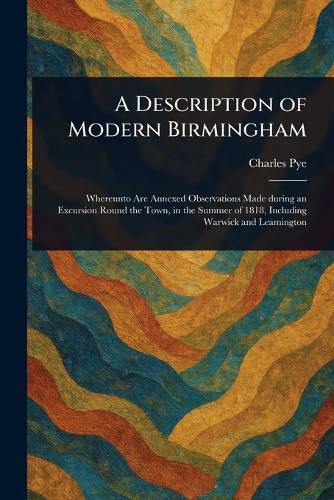Readings Newsletter
Become a Readings Member to make your shopping experience even easier.
Sign in or sign up for free!
You’re not far away from qualifying for FREE standard shipping within Australia
You’ve qualified for FREE standard shipping within Australia
The cart is loading…






This title is printed to order. This book may have been self-published. If so, we cannot guarantee the quality of the content. In the main most books will have gone through the editing process however some may not. We therefore suggest that you be aware of this before ordering this book. If in doubt check either the author or publisher’s details as we are unable to accept any returns unless they are faulty. Please contact us if you have any questions.
Explore early 19th-century Birmingham, Warwick, and Leamington through the eyes of Charles Pye in "A Description of Modern Birmingham." This meticulously reprinted edition offers a fascinating journey into the heart of England, capturing the essence of these burgeoning towns as they stood in 1818.
More than just a guidebook, Pye's work provides insightful observations gleaned during a summer excursion, painting a vivid portrait of the region's social fabric, landmarks, and daily life. Travel through time and discover the historical significance of Warwick and Leamington alongside Birmingham, offering a unique perspective on their development.
Whether you're a history enthusiast, a travel aficionado, or simply curious about England's past, this book provides a rich and engaging experience. Delve into a bygone era and uncover the enduring charm of these iconic English locations.
This work has been selected by scholars as being culturally important, and is part of the knowledge base of civilization as we know it.
This work is in the public domain in the United States of America, and possibly other nations. Within the United States, you may freely copy and distribute this work, as no entity (individual or corporate) has a copyright on the body of the work.
Scholars believe, and we concur, that this work is important enough to be preserved, reproduced, and made generally available to the public. We appreciate your support of the preservation process, and thank you for being an important part of keeping this knowledge alive and relevant.
$9.00 standard shipping within Australia
FREE standard shipping within Australia for orders over $100.00
Express & International shipping calculated at checkout
This title is printed to order. This book may have been self-published. If so, we cannot guarantee the quality of the content. In the main most books will have gone through the editing process however some may not. We therefore suggest that you be aware of this before ordering this book. If in doubt check either the author or publisher’s details as we are unable to accept any returns unless they are faulty. Please contact us if you have any questions.
Explore early 19th-century Birmingham, Warwick, and Leamington through the eyes of Charles Pye in "A Description of Modern Birmingham." This meticulously reprinted edition offers a fascinating journey into the heart of England, capturing the essence of these burgeoning towns as they stood in 1818.
More than just a guidebook, Pye's work provides insightful observations gleaned during a summer excursion, painting a vivid portrait of the region's social fabric, landmarks, and daily life. Travel through time and discover the historical significance of Warwick and Leamington alongside Birmingham, offering a unique perspective on their development.
Whether you're a history enthusiast, a travel aficionado, or simply curious about England's past, this book provides a rich and engaging experience. Delve into a bygone era and uncover the enduring charm of these iconic English locations.
This work has been selected by scholars as being culturally important, and is part of the knowledge base of civilization as we know it.
This work is in the public domain in the United States of America, and possibly other nations. Within the United States, you may freely copy and distribute this work, as no entity (individual or corporate) has a copyright on the body of the work.
Scholars believe, and we concur, that this work is important enough to be preserved, reproduced, and made generally available to the public. We appreciate your support of the preservation process, and thank you for being an important part of keeping this knowledge alive and relevant.